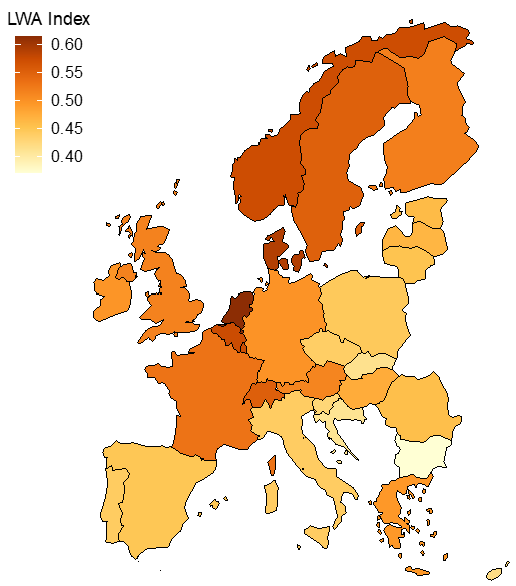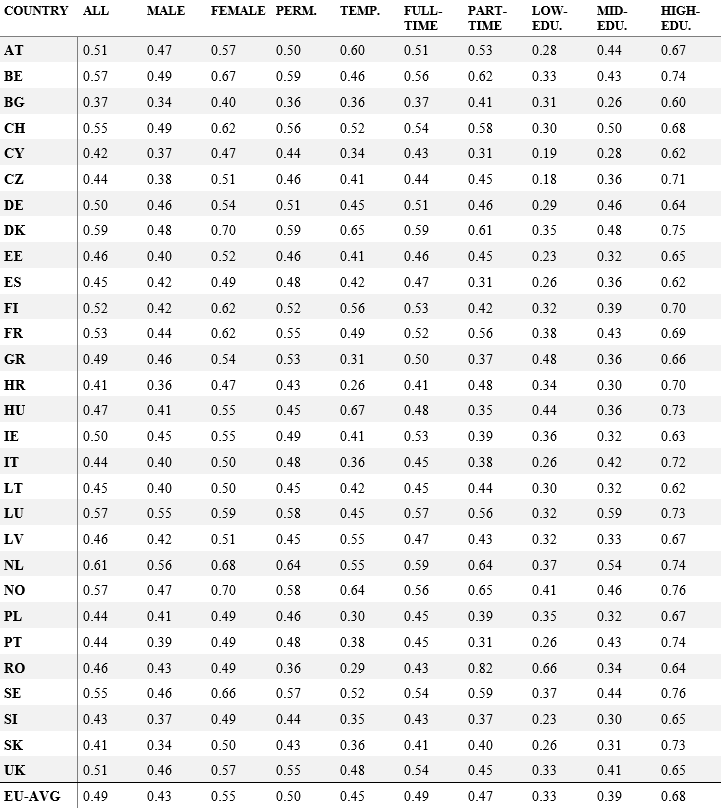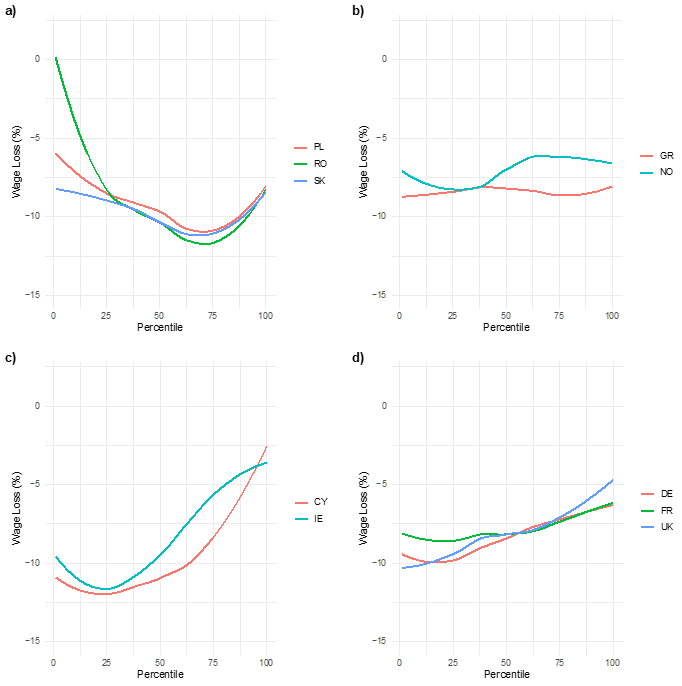The economic impact of COVID-19 is dramatic. The global economy is expected to shrink by 3% this year. Asia will not have economic growth for the first time in 60 years, the US and European economies are projected to contract between 6% and 8% (International Monetary Fund 2020), and global job losses are estimated to be over 200 million (International Labour Organization 2020).
The economic effects of the pandemic, however, will not be equally distributed (Dorn et al. 2020, McKibbin and Fernando 2020) and are likely to have distributional implications (Furceri et al. 2020, Lustig and Mariscal 2020).
Our findings strongly support this statement (Palomino et al. 2020). We estimate that the burden of the pandemic will be disproportionately borne by low-wage earners which, in the absence of compensating policies, will significantly increase poverty and inequality across Europe.
The lockdown and partial closure of economic activities were crucial to stop the pandemic and save lives, but their economic effects are likely to diminish economic cohesion between and within European countries.
Teleworking and lockdown ability to work in Europe
Even without considering the subsequent effects that may occur on the demand side (del Rio-Chanona et al. 2020), the lockdown and social distancing imposed by governments to limit the spread of COVID-19 have direct asymmetric effects on the labour market: in principle, only the jobs that can be done from home (‘teleworkable’) are unimpeded by the lockdown. Some occupations like health services and food sales are considered essential, so workers are not affected by their capacity to work from home. Meanwhile, certain economic activities like hospitality are closed under a lockdown and working is not at all possible.
To measure the capability of each worker to keep active under the lockdown, we calculate a ‘lockdown working ability’ index of workers (see Palomino et al. 2020). This measure takes into account the level of teleworking for each occupation (Dingel and Neiman 2020) and whether the occupation is considered essential or closed.
As shown in Figure 1, the average lockdown working ability index varies significantly across European countries with the Netherlands (0.61) the best prepared and Bulgaria (0.37) the worst prepared.
Figure 1 Lockdown working ability index across Europe
In Table 1 we highlight that our index varies significantly not only by country but also by:
- Gender: Women are less affected by social distancing than men.
- Type of job: Temporary and part-time workers are in general worse-prepared than their permanent and full-time counterparts.
- Education: There is a strong positive relationship between the level of education and the capacity to work under a lockdown in all European countries.
Teleworking capability is strongly correlated with higher wages both across occupations and across average levels by country (r = 0.76). However, the correlation between the lockdown working ability index and the average annual salary in a country is positive but very small (0.06).
Once essential and closed occupations are taken into consideration, the changes in wage inequality caused by the lockdown are difficult to foresee based only on the average level of ability to work under lockdown, and one needs to look at how potential wage losses are distributed.
Table 1 Lockdown working ability in Europe
Wage losses and lockdown incidence curves
Because not all workers are able to perform their job at home and some activities are closed, there will be potential wage losses for a significant part of the labour force that cannot fully work during the lockdown.
To simulate these wage losses, we consider several possible scenarios. Here, we show the results for (i) two months of lockdown and (ii) two months of lockdown plus six additional months of de-escalation with only partial functioning of the closed activities (80% of capacity).
Although each European country may have followed slightly different lockdown and de-escalation strategies, we simulate the same scenarios for all countries to ensure that differences across countries are exclusively due to their productive structure.
After ordering workers by wage centiles, we represent the relative change in their wage in ‘lockdown incidence curves’ (Figure 2), which makes it easy to appreciate which part of the wage distribution (low, middle, high) suffers the largest relative wage losses.
For a lockdown of two months, wage losses are sizeable across the wage distribution but vary significantly with the centile, being above 10% (of the annual salary) at certain percentiles in some countries.
Figure 2 Lockdown incidence curves in Europe (two months of lockdown)
Notes: The four panels show lockdown incidence curves (wage distribution versus wage loss, two-month lockdown scenario) for different groups of countries with similar curves.
As noted above, there is no straightforward relationship between the average wage of a country and its distribution of wage losses. Thus, we observe that the distribution of wage losses is similar for Norway and Greece (panel b), and Ireland and Cyprus (panel c), despite the fact that these countries have significantly different average wages.
Changes in poverty and wage inequality
The lockdown increases poverty in all countries. First, we find a 10.0% mean loss rate (P) for poor workers − those below 60% of the median wage − for the average of European countries under a lockdown of two months. This mean loss rate for poor workers goes up to 22.5% when an additional 6-month period with partial functioning of closed activities is considered. The mean loss rates are also sizeable by country (Table 2).
Second, the proportion of poor workers (headcount index, H) increases significantly for all European countries. The average increase is 4.9 percentage points under two months of lockdown and 14.5 percentage points with an additional partial closure period of six months.
These values imply that − in the absence of counteracting government measures − the percentage of poor people in Europe may substantially increase, even if lockdown does not last long.
By country, under the two-month lockdown scenario, we find the highest increase in poverty in Croatia by the headcount index, and the smallest increase in Switzerland.
When comparing wage inequality after the lockdown with the baseline, we observe that inequality increases in all European countries (Table 2). The countries with the lowest increases in the Gini coefficient under a two-month lockdown are the Netherlands (2.2%), Norway (2.3%), France (2.3%), Switzerland (2.6%), and Germany (2.6%). On the other extreme of the spectrum, we find Cyprus (4.9%), Czechia (4.8%), Hungary (4.7%), Slovenia (4.7%), and Slovakia (4.6%).
With an additional six-month period during which closed activities are functioning at 80%, the countries with the lowest increases in the Gini coefficient are Denmark (9.5%), France (9.9%), the Netherlands (10.5%), the UK (10.8%), and Germany (10.9%). Countries with the highest increases are Slovakia (21.2%), Cyprus (20.0%), Hungary (19.6%), Czechia (16.0%), and Slovenia (15.9%).
Table 2 Poverty and inequality changes in Europe
Notes: P is the mean loss rate for the poor, H is the headcount index, and G is the Gini inequality index. CL is partial closure, while 2m refers to 2 months. ∆RG is the relative change in the Gini index.
Finally, wage inequality both within and between European countries increase under a two-month lockdown, but inequality of wages inside countries increases more (5.04%) than inequality between countries (2.44%). Countries’ average wages diverge with the lockdown, although the main change in wage inequality happens within (not between) European countries.
In sum, our analysis reveals that the lockdown and de-escalation periods will potentially increase poverty and inequality sizeably in all European countries, even without accounting for second-round effects. Given that early relaxation of containment measures could have devastating effects for the health of citizens, we advocate for public policies that alleviate the distributional consequences that the lockdown may otherwise have.
References
del Rio-Chanona, R M, P Mealy, A Pichler, F Lafond and J D Farmer (2020), "Supply and demand shocks in the COVID-19 pandemic: An industry and occupation perspective", Covid Economics 6, 17 April.
Dingel, J, and B Neiman (2020), “How many jobs can be done at home?”, VoxEU.org, 6 April.
Dorn, F, C Fuest, M Göttert, C Krolage, S Lautenbacher, R Lehmann, S Link, S Möhrle, A Peichl, M Reif, S Sauer, M Stöckli, K Wohlrabe and T Wollmershäuser (2020), “The economic costs of the coronavirus shutdown for selected European countries: A scenario calculation”, EconPol Policy Brief 25.
Furceri, D, P Loungani, J D Ostry and P Pizzuto (2020), “COVID-19 will raise inequality if past pandemics are a guide”, VoxEU.org, 8 March.
International Labour Organization (2020), ILO monitor: COVID-19 and the world of work, 2nd edition, 7 April.
International Monetary Fund (2020), World economic outlook, April.
Lustig, N, and J Mariscal (2020), “How COVID-19 could be like the Global Financial Crisis (or worse)”, in R Baldwin and B Weder di Mauro (eds.), Mitigating the COVID Crises: Act Fast and Do Whatever it Takes, a VoxEU.org eBook, 18 March.
McKibbin, W, and R Fernando (2020), “The economic impact of COVID-19”, in R Baldwin and B Weder di Mauro (eds.), Economics in the Time of COVID-19, a VoxEU.org eBook, 6 March.
Palomino, J C, J G Rodríguez and R Sebastian (2020), “Wage inequality and poverty effects of lockdown and social distancing in Europe”, Covid Economics 25: 186–229.











